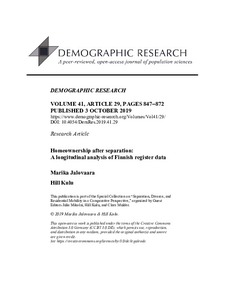Homeownership after separation: A longitudinal analysis of Finnish register data
Kulu Hill; Jalovaara Marika
https://urn.fi/URN:NBN:fi-fe2021042827382
Tiivistelmä
Abstract
Background: Divorce and separation have become common life-course events in many European countries. Previous studies show that separated individuals are likely to move from homeownership to renting and to experience a period of residential instability. However, little is known about postseparation homeownership levels in the long run.
Objective: This paper investigates homeownership levels after union dissolution. We extend previous research by examining changes in homeownership levels after separation by time (since union dissolution) and across population subgroups. We study whether and how postseparation homeownership levels are associated with repartnering and gender.
Methods: We use Finnish register data and logistic regression analysis.
Results: Compared to partnered individuals, homeownership levels among recently separated individuals are low. With increasing time since union dissolution, homeownership levels increase. However, the levels are high only among repartnered persons and remain low among separated individuals who remain single. Homeownership levels are slightly lower among separated women than among separated men.
Contribution: The study shows the short- and long-term effects of separation on individuals’ housing careers. After separation many individuals move from homeownership to rental accommodation, and most previous renters continue to rent. Separated individuals who form new unions are likely to move or return to homeownership. By contrast, those who remain unpartnered following separation have a low likelihood of living in owner-occupied dwellings. This likely reflects both individuals’ choices and their constrained opportunities in a country with high homeownership aspirations and levels.
Kokoelmat
- Rinnakkaistallenteet [19207]
